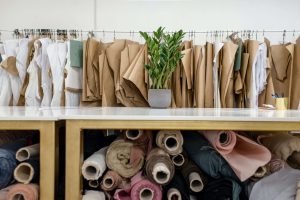Draping for Fashion Design- Learn the Significance
19/09/2023 2024-01-05 14:22Draping for Fashion Design- Learn the Significance
Draping is an essential part of fashion design that has been relevant since ancient times. Draping refers to the process of positioning a fabric on a standard-size dress form or mannequin to develop the structure of the garment design. Draping for fashion design helps the designer to visualise how an outfit will look upon completion. A designer manually manipulates the fabric on the dress form seeking the support of a sketch of the design.
Playing with the fabric, and understanding the flow, helps improvise and enhance the designs in the initial stage of dress-making. Once the draping is perfect, the fabric is removed from the dress form and used to develop the sewing pattern of the apparel. Fashion draping is usually done with a fabric similar in feel and texture to the real fabric to create an almost perfect preset for the outfit.
This blog will take you through the important aspects of draping and how it is significant to fashion design.
How It All Started?
Draping garment design has a long history which goes back to 3500 BCE. Egyptian and Mesopotamian designers used to cut fabric and secure loops over pins to create necklines and armholes. They used to work with diverse materials and fabrics to create beautifully designed garments. Greek designers also incorporated fabric draping techniques to invent draped outfits in the form of chiton, peplos, chlamys, and himation.

We can also witness the usage of draping in the past in many Roman and Indian cave paintings and ancient wood carvings, sculptures and terracotta’s, where men and women both donned the same unstitched clothes in varied draping styles. For instance, Uttariya is an upper-body garment that was worn in ancient times, while Antariya is the one worn on the lower body. And, then, there’s a saree which remains to be one of the most popular draped garments to day.
Draping as an important aspect of fashion flourished throughout the 16th and 17th centuries. After a little shift in its popularity due to the demand for more structured outfits in the 18th century, it made a comeback in the 19th century to create ornate gowns and other apparel.
Ever since it has remained an integral element of the fashion design process and has been used to date to create elaborate and suave garments.
Why is Draping So Important in Fashion Design?
The importance of draping for all the fashion students who aspire to be successful designers cannot be accentuated more. Draping helps a designer to visualise the three-dimensional form of a garment instead of working with techniques of flat two-dimensional pattern-making. Adjusting the fabric on the mannequin helps them achieve the perfect fit that would flatter a person’s body.

Designers love to use draping, as it allows them to feel the fabric when it flows over the dress form. Although you start working with rough design sketches, your designs become lively once you start draping the fabric, which helps you put more creativity and thought into your designs. You can work on any new ideas that come up without even sewing the fabric pieces together.
Draping clothing design also lets you understand different fabrics and teaches you how to work around them to get the shape and silhouette you desire. Moreover, it also helps you learn about the draping tools for fashion design, garment assembly methods, sewing darts, working with cut elements, etc., which necessary skills to start with flat pattern making.
To learn more about the process of draping and the different tools used in it, click here.
Why Should One Use Muslin Fabric in Draping
While deciding on the fabric used for draping, it is ideal to consider the type and purpose of the garment you are going to create. The fabric you choose should be perfect for draping so as create accurate clothing. As such, the fabric should be light or medium in weight and should flow freely. Designers use different kinds of fabrics for draping, including georgette, chiffon, cotton, organza, silk and more. However, they most commonly use muslin fabric for draping.

Muslin is versatile and works with various kinds of fabrics. It works best for woven garments, as it very well represents the texture and characteristics of the fabric used in the garment. Lightweight muslin is used for knitted fabrics, and medium weight for woollen and cotton garments.
If you are working with heavy wool or cotton, coarse muslin fabric provides the perfect drape and fitting. You can also consider canvas muslin while creating denim garments. Moreover, muslin is less expensive, so best for creating designs without bothering about the wastage of fabric.
Wrapping Up
Draping for fashion design techniques have been used for centuries now and have become an integral part of the fashion design process in current times. It not only lets you explore new ideas and spread your creative wings as a designer but also lets you create pieces that are accurate and perfect in fitting.
It lets you understand where all the design elements, such as darts, tucks, and more, fit better to make garments that are pleasing to the eyes. Experts designers emphasise learning the nuances of draping as it lets you envision your designs and breathe life into them.
If you are passionate about fashion design, then honing these skills is vital to empower the designer in you. You can learn the nitty gritty of draping and other crucial aspects of fashion design with a dedicated fashion design course. The three-year BSc in Fashion and Apparel Design program at JD School of Design will take you through the advanced techniques and methods used in draping and equip you to create beautifully crafted designs.













